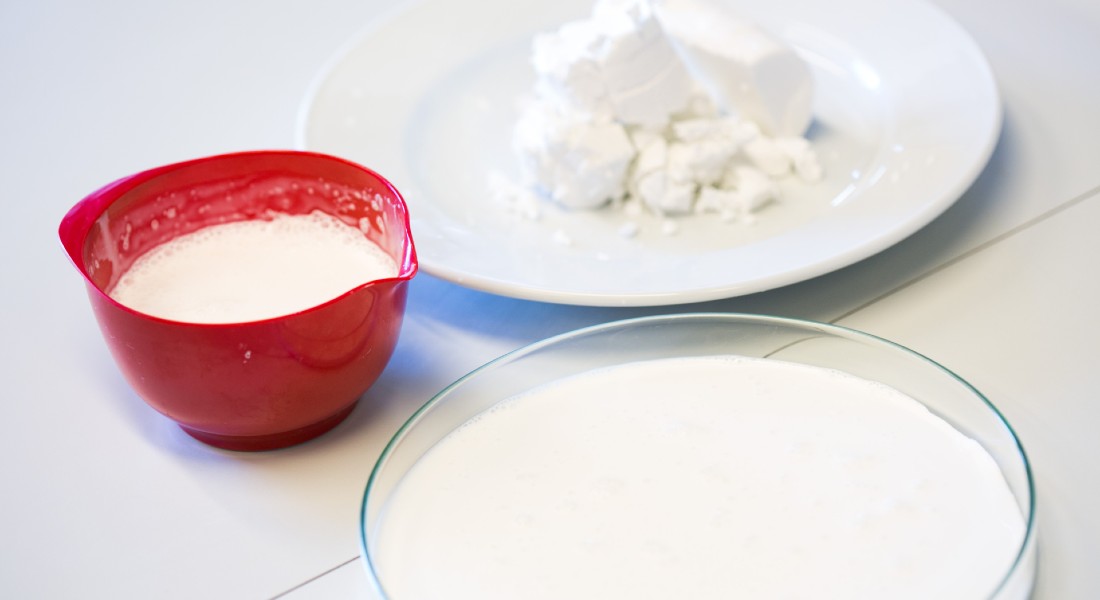Calcium and cheese - calcium dynamics during manufacturing of cheese
Calcium in milk and dairy products has intrigued many dairy scientists for more than a century. Calcium is well-recognized as a key micronutrient for human nutrition, that also influences processability, texture and taste of milk and dairy products. A variety of textures are created by transforming milk into cheese or other dairy products, using technological processes that are evolving to meet changing consumer demands. New consumer trends and new export markets create the need of knowledge to tailor the functionality of dairy products, and in this context, calcium has proven to play an important role.

By Prof. Lilia Ahrné (UCPH FOOD), Prof. Emeritus Leif Skibsted (UCPH FOOD), Senior R&D Scientist Søren Lillevang (ARLA FOODS INNOVATION), Senior R&D Scientist Valentin Rauh (ARLA FOODS INNOVATION), and Senior R&D Scientist Saeed Rahimi (ARLA FOODS INNOVATION).
This article was originally brought in Mælkeritidende on February 16, 2022. Click here to read the original article.
Bovine milk contains 1.0 – 1.2 g calcium/kg milk distributed in a dynamic equilibrium between colloidal (casein micelles) and the serum phase of milk. In the serum phase, containing ∼34% of the total calcium of milk, the calcium is either free as ionic calcium (35%) or bound to other components, such as citrate, phosphate and proteins. Caseins have high binding capacity to calcium, holding ∼66% of the total calcium, which prevents precipitation of calcium phosphate by forming amorphous calcium phosphate nanocomplexes that hold the supermolecular casein micelle structure together.
Partitioning of calcium between these two phases and speciation forms (e.g. ionic calcium or calcium bound to phosphates, or citrates) is highly dynamic and influenced by milk composition as well as external factors such as temperature, ionic strength and pH. Thus, processing steps used during the manufacture of dairy products, like concentration, acidification, salting, cooling and heating, all contribute to modify calcium speciation and partition, thereby influencing product yield, functionality and fouling of equipment.
Linking process knowledge with calcium chemistry
There is limited knowledge on how to control the dynamic calcium equilibrium between colloidal and serum phases and its speciation for the benefit of improved dairy product properties. Identification of approaches for qualitative and quantitative analysis of calcium in milk as a function of processing and storage, can represent a powerful tool for understanding, predict and control dairy-based products quality and improve production efficiency.
However, a prerequisite is to determine kinetics of calcium in these two phases and how they are affected by the interaction of calcium with dairy proteins, and other calcium-binding compounds during processing and storage. Most of the studies regarding calcium in milk have focused on the total amount of calcium in the serum phase or associated to the caseins and not on the dynamics of calcium transfer between free ionic and complex bounded calcium (soluble/insoluble) in the two phases (serum and colloidal).
To succeed on this challenge, we need to combine processing and food chemistry skills to extract knowledge that allow us to understand, select, and optimize processing steps and support targeted process design to obtain specific functionality.
The objective of the research activities
The few studies available in literature regarding calcium kinetics in dairy processing do not allow the dairy industry to extract the necessary knowledge to control calcium status during cheese manufacturing. This project, funded by the Milk Levy Fund and coordinated by University of Copenhagen in close collaboration with Arla Foods, aims to tackle this knowledge gap, using advanced methodologies for kinetic determination and in situ structure characterization methods.
Using state-of-the-art techniques and a process lead approach distinctive knowledge regarding relationships between calcium dynamics and functional properties of cheese will be generated, supporting the development of cheeses with extended functionality.
How can the industry benefit from this research?
The project will provide the calcium balances during processing that will contribute to improve cheese functionality, reduce milk losses and improve yield, through a better management of calcium in milk during production of dairy products. The specific focus on processing steps associated to cheese production will contribute to the development of cheeses with targeted textural properties leading to increased sales and export opportunities.
Consumers and retailers demand mozzarella, yellow cheeses and mould cheeses with unique textures and, in some cases with extended functionalities, such as stretchability and melting properties. These properties are strongly associated with calcium and binding of calcium to proteins and salt anions during cheese manufacturing.
Related News
Contact
Professor at the Department of Food Science at the University of Copenhagen (UCPH FOOD) Lilia Ahrné, lilia@food.ku.dk
Professor emeritus at UCPH FOOD Leif Skibsted, ls@food.ku.dk
Or
Communications officer at UCPH FOOD Lene Hundborg Koss, lene.h.koss@food.ku.dk
Project facts
Title: Calcium dynamics during manufacturing of cheese (PROCALCIUM)
Project manager: Professor Lilia Ahrné, Department of Food Science, University of Copenhagen
Participants: Arla Foods
Project period: 1.10.2021 – 31.04.2023
Objective: To understand how calcium dynamics can be controlled during pro-cessing as a way to increase yield and modulate the texture and functionality of added value dairy products, such as premium cheeses
Summary
Calcium partitioning between colloidal and serum phase of milk is of major importance during the manufacture of cheeses affecting cheese yield, cheese quality, and cheese functionality, e.g. stretchability and melting properties. Monitoring of calcium partitioning in real-time during processing and storage will allow to extract kinetics to be used to tailor the functionality of cheese products and improve production efficiency.
